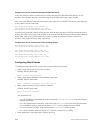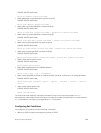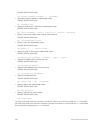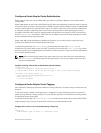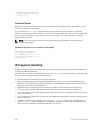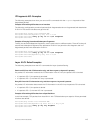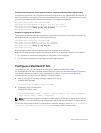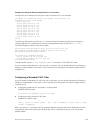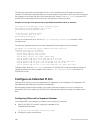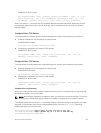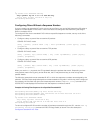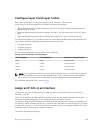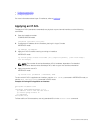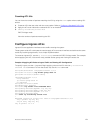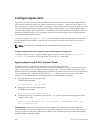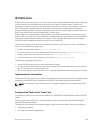
The following example shows a standard IP ACL in which Dell Networking OS assigns the sequence
numbers. The filters were assigned sequence numbers based on the order in which they were configured
(for example, the first filter was given the lowest sequence number). The show config command in IP
ACCESS LIST mode displays the two filters with the sequence numbers 5 and 10.
Example of Viewing a Filter Sequence for a Specified Standard ACL and for an Interface
Dell(config-route-map)#ip access standard kigali
Dell(config-std-nacl)#permit 10.1.0.0/16
Dell(config-std-nacl)#show config
!
ip access-list standard kigali
seq 5 permit 10.1.0.0/16
Dell(config-std-nacl)#
To view all configured IP ACLs, use the show ip accounting access-list command in EXEC
Privilege mode.
The following examples shows how to view a standard ACL filter sequence for an interface.
Dell#show ip accounting access example interface gig 4/12
Extended IP access list example
seq 15 deny udp any any eq 111
seq 20 deny udp any any eq 2049
seq 25 deny udp any any eq 31337
seq 30 deny tcp any any range 12345 12346
seq 35 permit udp host 10.21.126.225 10.4.5.0 /28
seq 40 permit udp host 10.21.126.226 10.4.5.0 /28
seq 45 permit udp 10.8.0.0 /16 10.50.188.118 /31 range 1812 1813
seq 50 permit tcp 10.8.0.0 /16 10.50.188.118 /31 eq 49
seq 55 permit udp 10.15.1.0 /24 10.50.188.118 /31 range 1812 1813
To delete a filter, enter the show config command in IP ACCESS LIST mode and locate the sequence
number of the filter you want to delete. Then use the no seq sequence-number command in IP
ACCESS LIST mode.
Configure an Extended IP ACL
Extended IP ACLs filter on source and destination IP addresses, IP host addresses, TCP addresses, TCP
host addresses, UDP addresses, and UDP host addresses.
Because traffic passes through the filter in the order of the filter’s sequence, you can configure the
extended IP ACL by first entering IP ACCESS LIST mode and then assigning a sequence number to the
filter.
Configuring Filters with a Sequence Number
To configure filters with a sequence number, use the following commands.
1. Enter IP ACCESS LIST mode by creating an extended IP ACL.
CONFIGURATION mode
ip access-list extended access-list-name
2. Configure a drop or forward filter.
116
Access Control Lists (ACLs)



